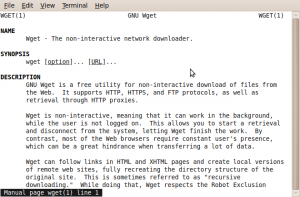Comandos interesantes: Manual wget
| Categorías internet, Linux, Sistemas Operativos, Software Libre, Tutoriales | Fecha 07-02-2010 | Comentario 0
Wget es un comando en Linux muy interesante y poderoso. Su función más simple es descargar archivos desde la web, soportando transferencias sobre protocolos como FTP, HTTP y HTTPS.
Pues como se pueden descargar archivos, cuando intentamos descargar una página, simplemente WGET nos trae el contenido HTML de esta página. Ahí es que viene lo de interesante, pues este comando tiene unas opciones sumamente poderosas, las cuales podemos utilizar para crear arañas, por ejemplo, como es la opción “-r”, que se refiere a recursivo.
La mejor forma de estudiar este comando es usar el manual, escribiendo el comando:
$ man wget
Como ya ustedes saben, “man” es un comando para desplegar manuales en Linux, así que sigan investigando sobre este comando que es realmente útil.
Aquí les dejo la lista de opciones que acepta el comando, que se despliega al escribir:
$ wget –help
GNU Wget 1.11.4, a non-interactive network retriever.
Usage: wget [OPTION]… [URL]…
Mandatory arguments to long options are mandatory for short options too.
Startup:
-V, –version display the version of Wget and exit.
-h, –help print this help.
-b, –background go to background after startup.
-e, –execute=COMMAND execute a `.wgetrc’-style command.
Logging and input file:
-o, –output-file=FILE log messages to FILE.
-a, –append-output=FILE append messages to FILE.
-d, –debug print lots of debugging information.
-q, –quiet quiet (no output).
-v, –verbose be verbose (this is the default).
-nv, –no-verbose turn off verboseness, without being quiet.
-i, –input-file=FILE download URLs found in FILE.
-F, –force-html treat input file as HTML.
-B, –base=URL prepends URL to relative links in -F -i file.
Download:
-t, –tries=NUMBER set number of retries to NUMBER (0 unlimits).
–retry-connrefused retry even if connection is refused.
-O, –output-document=FILE write documents to FILE.
-nc, –no-clobber skip downloads that would download to
existing files.
-c, –continue resume getting a partially-downloaded file.
–progress=TYPE select progress gauge type.
-N, –timestamping don’t re-retrieve files unless newer than
local.
-S, –server-response print server response.
–spider don’t download anything.
-T, –timeout=SECONDS set all timeout values to SECONDS.
–dns-timeout=SECS set the DNS lookup timeout to SECS.
–connect-timeout=SECS set the connect timeout to SECS.
–read-timeout=SECS set the read timeout to SECS.
-w, –wait=SECONDS wait SECONDS between retrievals.
–waitretry=SECONDS wait 1..SECONDS between retries of a retrieval.
–random-wait wait from 0…2*WAIT secs between retrievals.
–no-proxy explicitly turn off proxy.
-Q, –quota=NUMBER set retrieval quota to NUMBER.
–bind-address=ADDRESS bind to ADDRESS (hostname or IP) on local host.
–limit-rate=RATE limit download rate to RATE.
–no-dns-cache disable caching DNS lookups.
–restrict-file-names=OS restrict chars in file names to ones OS allows.
–ignore-case ignore case when matching files/directories.
-4, –inet4-only connect only to IPv4 addresses.
-6, –inet6-only connect only to IPv6 addresses.
–prefer-family=FAMILY connect first to addresses of specified family,
one of IPv6, IPv4, or none.
–user=USER set both ftp and http user to USER.
–password=PASS set both ftp and http password to PASS.
Directories:
-nd, –no-directories don’t create directories.
-x, –force-directories force creation of directories.
-nH, –no-host-directories don’t create host directories.
–protocol-directories use protocol name in directories.
-P, –directory-prefix=PREFIX save files to PREFIX/…
–cut-dirs=NUMBER ignore NUMBER remote directory components.
HTTP options:
–http-user=USER set http user to USER.
–http-password=PASS set http password to PASS.
–no-cache disallow server-cached data.
-E, –html-extension save HTML documents with `.html’ extension.
–ignore-length ignore `Content-Length’ header field.
–header=STRING insert STRING among the headers.
–max-redirect maximum redirections allowed per page.
–proxy-user=USER set USER as proxy username.
–proxy-password=PASS set PASS as proxy password.
–referer=URL include `Referer: URL’ header in HTTP request.
–save-headers save the HTTP headers to file.
-U, –user-agent=AGENT identify as AGENT instead of Wget/VERSION.
–no-http-keep-alive disable HTTP keep-alive (persistent connections).
–no-cookies don’t use cookies.
–load-cookies=FILE load cookies from FILE before session.
–save-cookies=FILE save cookies to FILE after session.
–keep-session-cookies load and save session (non-permanent) cookies.
–post-data=STRING use the POST method; send STRING as the data.
–post-file=FILE use the POST method; send contents of FILE.
–content-disposition honor the Content-Disposition header when
choosing local file names (EXPERIMENTAL).
–auth-no-challenge Send Basic HTTP authentication information
without first waiting for the server’s
challenge.
HTTPS (SSL/TLS) options:
–secure-protocol=PR choose secure protocol, one of auto, SSLv2,
SSLv3, and TLSv1.
–no-check-certificate don’t validate the server’s certificate.
–certificate=FILE client certificate file.
–certificate-type=TYPE client certificate type, PEM or DER.
–private-key=FILE private key file.
–private-key-type=TYPE private key type, PEM or DER.
–ca-certificate=FILE file with the bundle of CA’s.
–ca-directory=DIR directory where hash list of CA’s is stored.
–random-file=FILE file with random data for seeding the SSL PRNG.
–egd-file=FILE file naming the EGD socket with random data.
FTP options:
–ftp-user=USER set ftp user to USER.
–ftp-password=PASS set ftp password to PASS.
–no-remove-listing don’t remove `.listing’ files.
–no-glob turn off FTP file name globbing.
–no-passive-ftp disable the “passive” transfer mode.
–retr-symlinks when recursing, get linked-to files (not dir).
–preserve-permissions preserve remote file permissions.
Recursive download:
-r, –recursive specify recursive download.
-l, –level=NUMBER maximum recursion depth (inf or 0 for infinite).
–delete-after delete files locally after downloading them.
-k, –convert-links make links in downloaded HTML point to local files.
-K, –backup-converted before converting file X, back up as X.orig.
-m, –mirror shortcut for -N -r -l inf –no-remove-listing.
-p, –page-requisites get all images, etc. needed to display HTML page.
–strict-comments turn on strict (SGML) handling of HTML comments.
Recursive accept/reject:
-A, –accept=LIST comma-separated list of accepted extensions.
-R, –reject=LIST comma-separated list of rejected extensions.
-D, –domains=LIST comma-separated list of accepted domains.
–exclude-domains=LIST comma-separated list of rejected domains.
–follow-ftp follow FTP links from HTML documents.
–follow-tags=LIST comma-separated list of followed HTML tags.
–ignore-tags=LIST comma-separated list of ignored HTML tags.
-H, –span-hosts go to foreign hosts when recursive.
-L, –relative follow relative links only.
-I, –include-directories=LIST list of allowed directories.
-X, –exclude-directories=LIST list of excluded directories.
-np, –no-parent don’t ascend to the parent directory.

